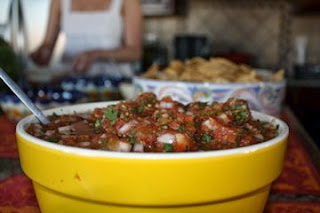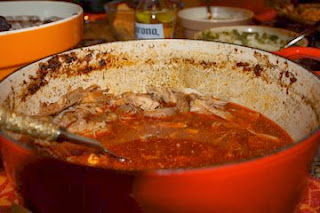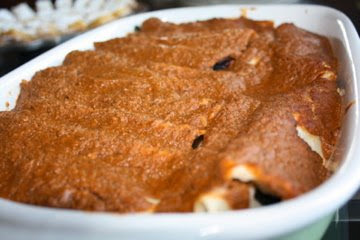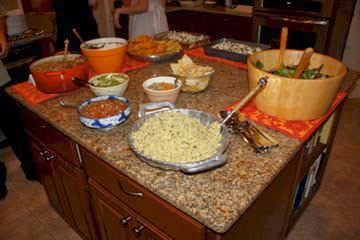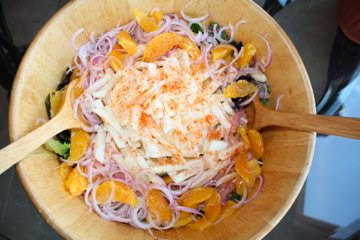The food of Lebanon is particularly known for its use of legumes (garbanzos and lentils), grains (bulgur and rice), lemon, olive oil, yogurt, pomegranate, herbs (parsley and mint), and spices (sumac, cinnamon, cumin). Also, the use of fresh, seasonal vegetables plays an important role in Lebanese cuisine; some of the most prominent include eggplant, bell pepper, cucumber, tomato, zucchini, and spinach.
An important tradition during family gatherings is the practice of mezze--an array of small dishes and appetizers served with drinks. The tradition of mezze has a long history and remains a favorite aspect of the Lebanese meal. It's hard to imagine why not: a variety of tasty foods with different flavors and textures, served with warm, pita-like bread (khobz halabi), accompanied with olives, tomatoes, cucumbers and radishes. This practice is similar to the Spanish tapas or the Italian antipasto.
The first recipe I want to share with you is one of the best lentil dishes I have tasted. It was published in Food and Wine by Musa Dagdeviren, chef-owner of three famous kebab houses in Istanbul. The recipe calls for a generous amount of pomegranate molasses, which is drizzled over a stew of lentils, eggplant, tomatoes and green chilies. I love the way that the ingredients are layered so that the flavors and textures of the different ingredients stay distinct.
Eggplant and Lentil Stew with Pomegranate Molasses
From Food and Wine
Serves 6.
One 1 1/2-pound long, narrow eggplant
Salt
1/2 cup lentils
Water
2/3 cup extra-virgin olive oil
1 medium onion, finely chopped
4 medium garlic cloves, minced
2 medium tomatoes, chopped
2 long green chiles, such as Anaheims—stemmed, seeded and coarsely chopped
2 tablespoons chopped mint leaves
1 tablespoon tomato paste
1/4 teaspoon crushed red pepper
1/4 cup pomegranate molasses
- Partially peel the eggplant so it has lengthwise stripes, then cut it lengthwise into 4 slices. Score each slice on 1 side in a crosshatch pattern. Cut each slice crosswise into 3 pieces and set on a rimmed baking sheet. Sprinkle with salt. Let stand for 1 hour.
- Meanwhile, in a small saucepan, cover the lentils with 2 inches of water and bring to a boil. Reduce the heat to moderate and simmer until tender, about 15 minutes. Drain the lentils.
- Coat a small enameled cast-iron casserole with 1 tablespoon of the olive oil. In a bowl, toss the onion with the garlic, tomatoes, green chiles, mint, tomato paste, crushed red pepper and 2 teaspoons of salt.
- Rinse the eggplant and pat dry. Spread 1/2 cup of the vegetable mixture in the casserole and top with half of the eggplant. Cover with half of the lentils and half of the remaining vegetable mixture. Top with the remaining eggplant, lentils and vegetables. Pour the remaining olive oil around the side and over the vegetables, then drizzle with the pomegranate molasses.
- Bring the stew to a boil. Cover and cook over low heat until the eggplant is very tender, about 1 1/2 hours. Serve hot, warm or at room temperature.
Lebanese Salad in Lavash
This recipe is perfect for lunch or a light dinner. The salad can also be served in a bowl with warm flat bread on the side. I enjoyed mine with a side of crunchy Persian cucumbers and tabbouleh.
Makes 4 half wraps.
Serves 2-4.
1 large eggplant
extra virgin olive oil
sea salt and freshly ground pepper
2 tablespoons pomegranate molasses
juice of 1/2 lemon
1 clove garlic, minced
2 9 x 10-inch sheets of lavash
1 cup arugula
1 medium tomato, thinly sliced
2-3 ounces feta cheese, crumbled
1/4 cup fresh mint, minced
2 tablespoons fresh parsley, minced
- Preheat oven to 400 degrees. Line a baking sheet with foil and brush with olive oil.
- Peel eggplant and cut crosswise into slices about 1/2-inch thick. Place on prepared baking sheet; brush with oil and sprinkle with salt. Bake about 30 minutes, until soft and browned.
- Meanwhile, in a small bowl whisk together pomegranate molasses, lemon juice, garlic, and 2 tablespoons olive oil. Sprinkle with salt and pepper.
- For each wrap, arrange 1 sheet of lavash on a work surface and use half the ingredients. Arrange arugula down the center, followed by roasted eggplant and tomatoes. Top with feta cheese and chopped herbs. Drizzle with dressing. Wrap tightly and cut in half.

